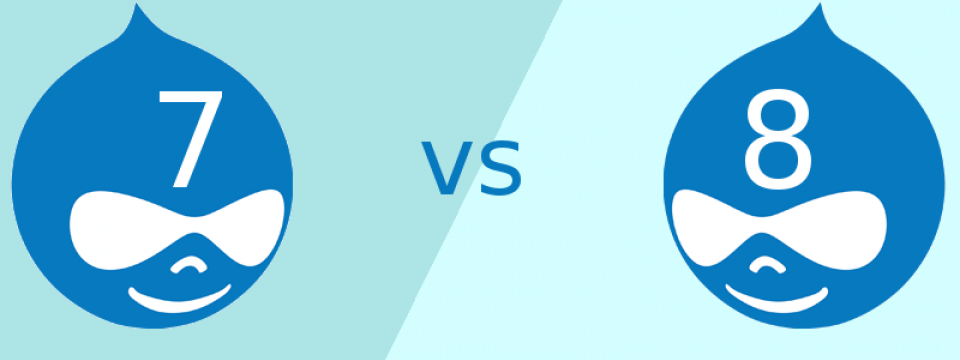‘Drupal 8 VS Drupal 7‘ has been at the centre of multiple debates on Drupal’s global forums. Content creators, web developers, marketers, and even individual users have been expressing their views on the same.
Drupal 8, with its rich features, enhanced compatibility, and easier accessibility has been notably successful in maintaining its 18-year-old legacy of success. In line with its continued list of achievements, introducing 200 new features, Drupal 8 promises to deliver a range of upgrades and a better overall experience to the users.
With its diverse pool of users in the field ranging from private web-users, corporates to governmental entities, the open source CMS-cum-content management framework has significantly made its impression by expanding its initial back-end framework provision, and currently, Drupal websites acquire more than 2.3% of the cumulative global web network.
With reference to all the details and through experiential learning of the software, in this article, we will briefly discuss all the advantages of Drupal 8 over its predecessor, Drupal 7 for distinct users.
Better Adaptability for Drupal Developers
For fresh developers, familiar with frameworks like Handlebars, and for those who are not quite confident about using Drupal, Drupal 8 consists of a new PHP-based theme engine – Twig – to address the requirement of simpler syntax as in the case of Symfony2.
The new modules – HTTP Basic Authentication, HAL, serialization, and RESTful web services in Drupal 8 facilitate easier web services development and using the CMS data source, content can be output in JSON or XML format.
The Flexibility of Twig
Easy to learn tag-based syntax and open architecture of Twig helps Drupal 8 users to template their own language constructs. Clearer error messages make the debugging much easier than it has been in the past decade.
Keeping Up with the Speed
Users generally walk out of any website that takes more than 3 seconds to load. Therefore, it is essential for web developers to create a faster website.
Although not as fast as static elements, in Drupal 8, Bigpipe allows dynamic uncacheable parts of a Drupal website to be downloaded instead of waiting for the whole page to load. For marketers, this can significantly decrease the bounce rate as well as user abandonment because of slow website loading speed.
Increased Potential for Content Curators and Marketers
Drupal 8 comes with activating and deactivating functions for the editors along with adaptable quick-edit and customization options such as drag-and-drop UI for toolbar and captions.
The latest CKEditor with embedded WYSIWYG (What You See is What You Get) function assists in easier content creation and development. Its default support for new field types such as date, links, contact information and reference allows the users to add text fields, forms, nodes, and blocks by simply defining the field name and type. The uncomplicated interface allows not only Drupal developers but also non-developers and coders to work on minute details such as caption placement and image alignment, with the ease similar to that of scrolling the website.
The New Views
Instead of using views as modules in Drupal 7, they are now a core component in Drupal 8. This enables views to be directly accessed without devoting additional time or efforts. Due to the built-in configuration management, views and similar configuration elements such as content type and fields can be either stored in files, moved to web server from the local development environment, or users can easily use a version control system to track any configuration changes.
Easier Dependency Management
Composer, supported by Drupal 8, can significantly boost your project management ability. The composer can install as well as update all the third-party libraries and their dependencies for improved efficiency.
An Overall Package for Marketers
Schema.org markup allows SEO-friendly content structure and using Twig, front-end programmers can create fast and secure templates for more functional and aesthetic websites to improve the user experience.
Content for Everyone
Unlike Drupal 7, in Drupal 8, the developers can use semantic HTML5 that allows static as well as dynamic content to create more usable user interactions. This improves responsiveness for mobile, tablet as well as desktop Drupal websites. Furthermore, CMS version 8 supports WAI-ARIA (Web Accessibility Initiative – Accessible Rich Internet Applications) technology for enhancing website accessibility on all the devices and enables the content developers to create targeted content even for the people with special needs.
No Language Barrier Anymore
Drupal 8 consists of 4 core modules to support the integration of 100 different languages. Translation for content, interface and easily configurable new strings with language maintenance ensures enhanced web communication for the users from all across the world, and for the Drupal developers to work on their preferred language. The multilingual feature also allows the users to block the visibility of a Drupal website for a specific language.
Last But Not the Least…
Drupal core usage across the globe has been steadily on the rise since its inception. Consequently, because of the path-breaking updates right from the introduction of the software to Drupal 8.6.0 to the current Drupal 8.7.x-dev, the Drupal community has been thriving with more than 1.3 million members and 112,500 active users all across the globe which is expected to grow even further.
Just like any new update, there are a number of advantages for every professional in the latest Drupal 8, however, if you wish to upgrade or migrate from any version of Drupal to Drupal 8, it is strongly advised that you should acquire a comprehensive knowledge of both the versions before finalizing the same.

